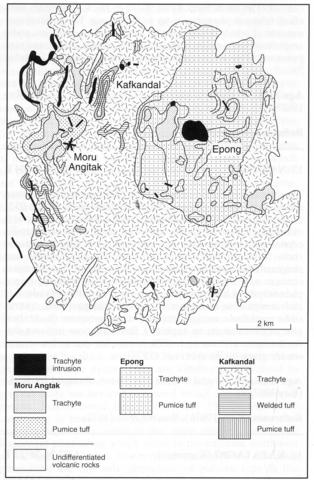stripes
Kafkandal volcano is approximately circular in plan and 10 km in diameter but its full extent is concealed by volcanic products from the Nasaken (No. 085-00-017), Kachila (No. 085-00-024) and Ribkwo (No. 085-00-025) volcanoes. The three main centres of Kafkandal, Epong and Moru Angitak have been identified with the three resulting volcanic units being separated by disconformities. Each unit comprises trachyte lavas and pumice tuffs with minor welded tuffs found mainly in the Kafkandal unit. The lava flows are 20-30 m thick and the pyroclastic rocks increase in thickness rapidly towards the three main centres with 300 m of chaotic trachytic pumice tuffs at Moru Angitak. Although predominantly trachytic the lavas vary to quartz trachytes and rhyolites with 20 % modal quartz. Phenocrysts of alkali feldspar are generally present varying modally from 5 to 20%; more rare are phenocrysts of hedenbergite, diopsidic augite, magnetite, fayalite, arfvedsonite and aenigmatite. The groundmass is dominated by alkali feldspar with sodic amphibole, usually in mossy, poikilitic aggregates, aenigmatite, quartz and minor pyroxene. An analysis of trachyte is given by Key (1987b, Table 5). Numerous trachyte plugs and dykes are coeval with and cut the extrusive rocks, one plug being nearly a kilometre in diameter.
KEY, R.M. 1987b. Geology of the Maralal area. Report, Geological Survey of Kenya, 105: 1-93. WEBB, P.K. and WEAVER, S.D. 1976. Trachyte shield volcanoes: a new volcanic form from South Turkana, Kenya. Bulletin Volcanologique, 39: 294-312.

